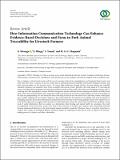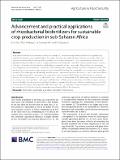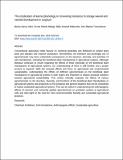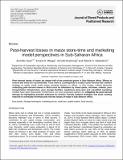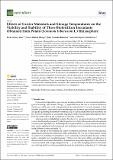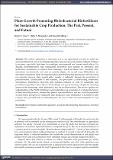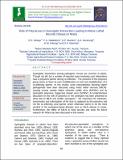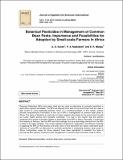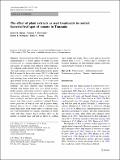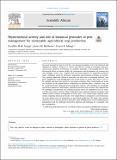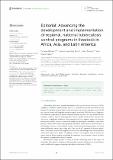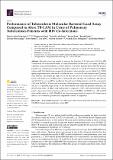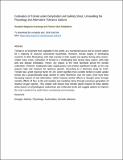Research Articles [LISBE]: Recent submissions
Now showing items 281-300 of 886
-
How Information Communication Technology Can Enhance Evidence-Based Decisions and Farm-to-Fork Animal Traceability for Livestock Farmers
(Hindawi, 2020-12-17)Due to changes in the livestock sector and the rise of consumer demand for comprehensive and integrated food security and safety, there has been a concern on the use of farm data in enhancing animal traceability and ... -
Advancement and practical applications of rhizobacterial biofertilizers for sustainable crop production in sub-Saharan Africa
(BioMed Central, 2021-12-13)Agricultural intensification continues in Africa in attempts to meet the rising food demands of the equally rising population. However, most arable lands in the region are characterized by nutrient deficiency and over-reliance ... -
Effects of agrochemicals on the beneficial plant rhizobacteria in agricultural systems
(Springer Nature, 2021-09-18)Conventional agriculture relies heavily on chemical pesticides and fertilizers to control plant pests and diseases and improve production. Nevertheless, the intensive and prolonged use of agrochemicals may have undesirable ... -
Post-harvest losses in maize store-time and marketing model perspectives in Sub-Saharan Africa
(Academic Journals, 2019-01-31)Post‒harvest losses of maize are almost half of the produced grains in Sub‒Saharan Africa. Efforts to reverse this trend are recommended. Thus, there is a prerequisite to create a post‒harvest loss resilient strategy ... -
Effects of Carrier Materials and Storage Temperatures on the Viability and Stability of Three Biofertilizer Inoculants Obtained from Potato (Solanum tuberosum L.) Rhizosphere
(MDPI, 2022-01-20)Biofertilizer technology continues to be derailed by the short shelf life of inoculants. The present study investigated the suitability of wheat-bran (WB), rice-husks (RH), farmyard-manure (FYM), bagasse (BG), and sawdust ... -
Plant Growth Promoting Rhizobacterial Biofertilizers for Sustainable Crop Production: The Past, Present, and Future
(Preprints, 2020-09-26)The world’s population is increasing and so are agricultural activities to match the growing demand for food. Conventional agricultural practices generally employ artificial fertilizers to increase crop yields, but these ... -
Role of Potyviruses in Synergistic Interaction Leading to Maize Lethal Necrotic Disease on Maize
(International Journal of Current Microbiology and Applied Sciences, 2016-06-10)Synergistic interactions among pathogenic viruses are common in plants. Though not all, but a number of reported cases involving such interactions have a potyvirus partner during co-infection. The presence of the ... -
Rhizobacteria-Based Technology for Sustainable Cropping of Potato (Solanum tuberosum L.)
(Springer, 2019-08-15)Potato (Solanum tuberosum L.) is one of the most important food crops worldwide but its cultivation is affected by numerous challenges including pests, diseases and high fertiliser requirements which have associated ... -
Status and Management of Cashew Disease in Tanzania
(Infogain Publication, 2018-09)Cashew (Anacardium occidentale L.)is one of the most important export cropsand the main source of cash income in the southern part of Tanzania. However it is challenged by a number of factors such as drought, declining ... -
Botanical Pesticides in Management of Common Bean Pests: Importance and Possibilities for Adoption by Small-scale Farmers in Africa
(Journal of Applied Life Sciences International, 2017-06-17)Botanical Pesticides (BPs) have been cited and are used as alternative to synthetic pesticides in agricultural systems worldwide. The BPs are believed to be safe to the environment and are used in pest control to avoid ... -
Drought Tolerance Mechanisms in Plants: Physiological Responses Associated with Water Deficit Stress in Solanum lycopersicum
(Advances in Crop Science and Technology, 2018-05-17)Drought is among the top largest causes of agricultural productivity losses globally. Tomato (Solanum lycopersicum L.) is a commercially important crop considerably hampered by drought. It is considered a drought sensitive ... -
The effect of plant extracts as seed treatments to control bacterial leaf spot of tomato in Tanzania
(Springer Nature, 2012-05-05)Bacterial leaf spot (BLS) caused by seed-borne xanthomonads is a serious disease of tomato (Solanum lycopersicum L.), causing significant losses in both yield and quality. To identify more effective control measures, we ... -
Phytochemical activity and role of botanical pesticides in pest management for sustainable agricultural crop production
(Elsevier, 2020-03)Increased demand for food to feed the ever-growing population led to development and adoption of synthetic chemicals as a quick and effective strategy of managing crop pests and diseases. However, overreliance on synthetic ... -
Better nitrogen fertilizer management improved Mchare banana productivity and profitability in northern highlands, Tanzania
(MDPI, 2023-05-20)Declining land productivity is a major problem constraining banana (Musa spp.) production in Tanzania. Banana fruit yield consequently reaches only 15% of the potential, primarily due to inadequate soil nutrient ... -
Advancing the development and implementation of regional, national tuberculosis control programs in livestock in Africa, Asia, and Latin America
(Frontiers in Veterinary Science, 2023-04-18)Tuberculosis in livestock caused by members of the Mycobacterium tuberculosis (MTb) complex is a notifiable zoonotic animal disease (1), which has been eradicated or held to very low prevalence levels in many high-income ... -
Epidemiology of Q-fever in domestic ruminants and humans in Africa. A systematic review
(CABI One Health, 2022-11-17)Q-fever is a zoonotic infectious disease caused by the gram-negative, intracellular, spore-forming bacterium Coxiella burnetii . Infected ruminants (cattle, sheep, and goats) are the reservoirs of the pathogen and thus ... -
Seroprevalence and Risk Factors for Q fever (Coxiella burnetii) Exposure in Smallholder Dairy Cattle in Tanzania
(MDPI, 2022-11-28)Q fever is a zoonotic disease, resulting from infection with Coxiella burnetii. Infection in cattle can cause abortion and infertility, however, there is little epidemiological information regarding the disease in dairy ... -
Impact of N-Acetyl Cysteine (NAC) on Tuberculosis (TB) Patients—A Systematic Review
(MDPI, 2022-11-21)Sustained TB infection overproduces reactive oxygen species (ROS) as a host defense mechanism. Research shows ROS is destructive to lung tissue. Glutathione (GSH) neutralizes ROS, although it is consumed. NAC is a precursor ... -
Performance of Tuberculosis Molecular Bacterial Load Assay Compared to Alere TB-LAM in Urine of Pulmonary Tuberculosis Patients with HIV Co-Infections
(MDPI, 2023-02-23)Alternative tools are needed to improve the detection of M. tuberculosis (M. tb) in HIV co-infections. We evaluated the utility of Tuberculosis Molecular Bacterial Load Assay (TB-MBLA) compared to lipoarabinomannan (LAM) ... -
Cultivation of Tomato under Dehydration and Salinity Stress: Unravelling the Physiology and Alternative Tolerance Options
(IntechOpen, 2022-07-21)Tomato is an important fruit vegetable in the world, as a nutritional source and an income option for a majority of resource constrained households. However, tomato supply in developing countries is often fluctuating, with ...

